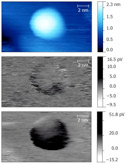By
Beckman Institute
Published on
Nov. 4, 2014
Lea Nienhaus
Imaging of Optical Absorption in PbS Quantum Dots by Scanning Tunneling Microscopy
Transparent, smooth, and conductive noble metal films are used in single molecule optical absorption detected by scanning tunneling microscopy (SMA-STM). This technique uses backside illumination to reduce tip heating effects. The evanescent wave of a laser undergoing total internal reflection excites molecules on the surface, thus changing their local density of states. The excitation laser is amplitude modulated, allowing for simultaneous detection of the STM current and its derivative by a lock-in amplifier. 15 nm thick platinum gold hybrid films deposited by electron beam evaporation onto c-plane sapphire substrates serve as substrates. Low resistance, sufficient light transmission and atomically flat island surfaces make these strong candidates for optical experiments. As expected, SMA-STM performed on quantum dots deposited by dry contact transfer onto a PtAu film, resulted in a strong, phase dependent localized absorption signal.
Yeonjoo Park
Functional Probabilistic Classification with Applications in Quantitative Ultrasound
Ultrasound imaging has long been used for safe, noninvasive imaging of soft tissues in medical applications. Quantitative ultrasound aims to make deeper use of the backscatter information in the ultrasound signal to characterize the nature of the tissue being scanned and enhance diagnosis of tumors, cysts, and other regions of interest. Computed measurements such as the frequency dependent backscatter coefficient (BSC) and attenuation have been shown in specific experiments to provide statistically significant detection of tissue differences using various processing techniques. Building on this work, this talk will discuss a functional classification of quantitative ultrasound signals to identify tumors and other regions of interest with uncertainty estimation. Although many classification algorithms are optimized for performance of the labeling, here the focus is on accurate estimation of the classification probabilities, which provide crucial information about the strength and uncertainty of the diagnostic information. The proposed method yields a degree of certainty for the classification result by providing the estimated probability distribution over a set of classes. The approach allows for irregular functional data in which curves are collected over varying and non-overlapped intervals, e.g., ultrasound transducers with varying center frequencies. Furthermore it can handle potential outlying curves by assuming heavy-tailed distribution for noise. In comparison with Gaussian classifiers, the proposed approach shows superior fit to ultrasound backscatter data and provides more realistic diagnostic probabilities robust to outlier measurements.
Cassandra Jacobs
Distributed Representations in Language: Evidence from the Mirror Effect in Recognition Memory
When we comprehend language, we take in both new and familiar information. Some of this familiar information comes in the forms of combinations of words we have heard before, called phrases, such as handsome wizard. Unfortunately, we cannot keep track of every possible word that could occur due to the combinatorial explosion. If our vocabulary is normally sized (10,000 words), then we would need to store almost 1 trillion three-word combinations! Despite this, some research in language comprehension and production has shown that we do show some sensitivity to how familiar word combinations are. In two experiments, we tested whether we represent and keep track of how familiar phrases are, or whether we only use word-level information in a recognition memory test. In recognition memory, unfamiliar words like hyena are surprisingly easier to remember, so our memory for familiar things like dog is actually worse. We found that while people do seem to know how common phrases are, words seem to contribute more to their ability to remember linguistic information. This is very surprising because it shows that multiword combinations are not just big words. We conclude that people solve the problem of the combinatorial explosion by storing multiword combinations relationally, and use meaning, not form, to guide their memory.


